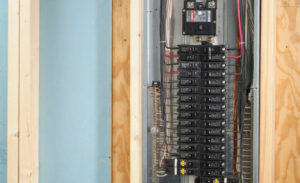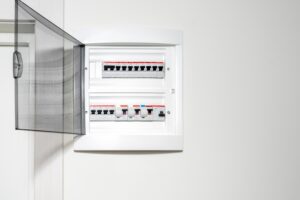Upgrading Your Electrical Panel: A Comprehensive Guide
Your home's electrical panel serves as the heart of your electrical system, distributing power throughout your home. However, like any other essential system, it can wear out over time. If you’ve noticed flickering lights, unusual smells, or circuit breakers frequently tripping, these are warning signs that your electrical panel may need an upgrade.
Not sure if your electrical panel can keep up with your home's growing power demands? Upgrading to a higher-capacity panel ensures that all your appliances and devices receive the power they need while improving overall safety. A new panel can prevent common electrical issues, such as lights dimming when using high-powered appliances like microwaves or air conditioners. According to Forbes, the average cost of upgrading an electrical panel is around $1,800 (as of 2023), but depending on the complexity of the project, costs can exceed $5,000.
This guide covers everything you need to know about upgrading your electrical panel—from recognizing the signs that indicate it’s time for an upgrade to understanding the costs and steps involved in replacing your panel.
1. Electrical Panel Component Costs
An electrical panel is a rectangular box mounted on a wall, containing the circuit breakers responsible for controlling the flow of electricity in your home. Each component within the panel plays a crucial role, and upgrading or replacing them comes with varying costs:
- Main Circuit Breaker: Controls power distribution to all connected circuits. A new main breaker box costs between $500 and $2,000, depending on its amperage and the number of circuits.
- Fuse Box: Older homes (built before the 1960s) often have fuse boxes, which should be replaced for safety. Swapping a fuse box for a modern breaker panel costs $1,500 to $2,000 or more if rewiring is required.
- Main Lug Panel: A subpanel (also called a downstream panel) designed to distribute additional power. Installation costs range from $400 to $1,750, depending on capacity.
- Subpanels: Used to expand circuit capacity beyond the main panel’s limit. Costs vary based on amperage and circuit configuration.
- Circuit Breakers: These safety devices shut off power during a fault. Standard 15- to 20-amp breakers cost $5 to $15, while larger 20-amp breakers cost $10 to $20. Replacing a breaker switch costs $100 to $200.
- Meter Box Replacement: The meter box houses the electric meter that tracks energy usage. Installing a new one costs between $100 and $650, including parts and labor.

2. Signs That It's Time to Upgrade Your Electrical Panel
Electrical panels typically last 25 to 40 years. While this range is broad, there are clear warning signs that indicate a need for an upgrade:
- Frequent Circuit Breaker Trips: If your breakers trip often, an overloaded electrical panel may be the cause.
- Not Enough Outlets: Relying on power strips and extension cords suggests your panel can’t handle your home’s electrical needs.
- Rust or Corrosion: If you notice rust, moisture, or damage inside your panel, call an electrician immediately, as this can pose a serious fire hazard.
- Insufficient Power Capacity: Dimming lights, hot electrical panels, or unusual noises from outlets may indicate an overloaded system.
- Sparking Outlets: Occasional tiny sparks are normal, but large, frequent sparks are a warning sign of electrical issues.
Replacing an outdated electrical panel enhances safety, reduces the risk of electrical fires, and allows appliances to operate without interruption. Additionally, many insurance companies offer lower premiums for homes with modern electrical panels.

3. Choosing the Right Panel Size
Electrical panels are rated in amperage (amps), which determines how much electricity your home can handle. Selecting the right size depends on your household's current and future power needs.
- 125-Amp Panel: Suitable for small homes with basic electrical needs. Ideal for replacing an existing panel without adding new loads.
- 200-Amp Panel: Best for homes with high power demands, supporting additional appliances, electric vehicle (EV) chargers, or future expansions.
- 400-Amp Panel: Designed for large homes with multiple high-power appliances, multiple EV chargers, and whole-home electrification projects.
Choosing the right panel size ensures that your electrical system can handle your energy needs efficiently.

4. Steps to Replace an Electrical Panel
If you're considering upgrading your electrical panel, it's crucial to hire a licensed electrician, as most jurisdictions require a permit for such work. Here’s what the process typically involves:
1) Consult a Professional
An electrician will assess your current electrical system and recommend the appropriate panel size and upgrades based on your home's needs and future plans.
2) Obtain Necessary Permits
Electrical panel upgrades require permits, which must be approved before work begins. Your electrician will handle this process.
3) Consider the Duration and Complexity
Replacing an electrical panel typically takes 4 to 8 hours, depending on the number of circuits and the complexity of the wiring.
4) Schedule a Power Disconnection
Your electrician will coordinate with the power company to temporarily disconnect your home's electricity before beginning the panel replacement. Try to schedule the upgrade when minimal power disruption is needed.
5) Install the New Panel
With the power turned off, the electrician will remove the old panel, replace necessary wiring, and install the new panel, breakers, and components.
6) Pass the Electrical Inspection
Before power is restored, a city or municipal inspector will review the installation to ensure compliance with safety standards. The electrician will meet with the inspector and schedule power reconnection once the panel passes inspection.
5. Conclusion
Upgrading your electrical panel is a crucial investment in safety, functionality, and home value. If you live in an older home with an outdated system or plan to add new appliances, an upgraded panel is essential for reliable power distribution.
Electrical work can be dangerous, so it’s always best to hire a professional electrician for the job. By ensuring your panel is properly installed and meets local regulations, you can enjoy a safer, more efficient, and future-proof electrical system.
Professiona Switchgear supplier and manufacturer
- Zhejiang GONGSHUN Electrical Co.,Ltd (electricgs.com), Our company was founded in the late 1990s, specializing in the production of inflatable cabinets, SF6 inflatable cabinets, and various high and low voltage complete sets of electrical equipment. It has multiple subsidiaries under its jurisdiction, including high-voltage load switch branch, high-voltage circuit breaker branch, high-voltage fuse branch, and technology development branch.Our technical expertise, comprehensive product portfolio and long-term rich experience are helping many customers in need to solve their power problems. We’re happy to help at any time. Whether you need application product advice or technical assistance, our global service team is committed to providing you with the right support. For more technical information about medium voltage earthing switch, feel free to contact us, send an email to gongshun@electric-cn.com
- Our company specializes in producing 12KV-40.5KV series high-voltage electrical products: FZN58, FLN48, FLN36, FZRN25, FZN21, FN18, ZFN16, FN12, FN8, FN7, FN5, XRNT, XRNP, VS1, ZN28, ZW8, ZW32, JN15, GN19, GN22, GN24, GN30, CLXGN15-12, HXGN □ -12, DXG-12 (L), DFW □ -12 high-voltage cable branch box, CLXGN □ -12 (SF6) series inflatable cabinet 12KV and 35KV cable accessories, etc; CLVXP-12 indoor AC high voltage fixed switchgear, CL-SIS-12 compact solid insulated ring main unit, professional assembly Schneider SC6 (SF6) series load switchgear, ABB produced SFG (SF6) series load switchgear and other series products; Distribution and agency of high-voltage load switches and inflatable cabinets produced by Schneider Electric and ABB; Siemens produces the 3AJ1 series of indoor medium voltage vacuum circuit breakers and other related products. The company has a complete range of products and has been operating safely on domestic and international power grids for a long time, receiving unanimous praise from both new and old users. Among them, multiple products such as FZRN25, FN12, FLN36-12, XRNT-12 have been exported to various countries and regions in East Asia, South Asia, Southeast Asia, Africa, and the United States.


